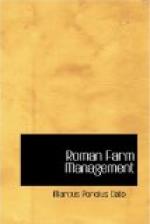“Let us then agree,” said Scrofa, “to exclude live stock from our consideration of the art of agriculture. Does any one want to exclude any thing else?”
“Are we to follow the book of the two Sasernas,” I inquired, “and discuss whether the manufacture of pottery is more related to agriculture than mining for silver or other metals? Doubtless the material comes out of the ground in both cases, but no one claims that quarrying for stone or washing sand has any thing to do with agriculture, so why bring in the potter? It is not a question of what comes out of the land, nor of what can be done profitably on a farm, for if it were it might as well be argued that had one a farm lying along a frequented road and a site on it convenient to travellers, it would be the farmer’s business to build a cross-roads tavern. But surely, however profitable this might prove, it would not make the speculation any part of agriculture. It is not, I repeat, whether the business is carried on on account of the land, nor out of the land, that it may be classed as a part of agriculture, but only if from planting the land one gains a profit.”
“You are jealous of this great writer,” interrupted Stolo. “Because of his unfortunate potteries you rebuke him captiously and give him no credit for all the admirable things which he says about matters which certainly relate to agriculture.”
At this sally, Scrofa, who knew the book and justly contemned it, smiled, whereupon Agrasius, who thought that he and Stolo alone knew the book demanded of Scrofa a quotation from it.
“Here is his recipe for getting rid of bugs,” said Scrofa. “’Steep a wild cucumber in water and where-ever you sprinkle it the bugs will disappear,’ and again, ’Grease your bed with ox gall mixed with vinegar.’”
Fundanius looked at Scrofa. “And yet Saserna gives good advice even if it is in a book on agriculture,” he said.
“Yes, by Hercules,” said Scrofa, “and especially in his recipe for removing superfluous hair, in which he bids you take a yellow frog and stew it down to a third of its size and then rub the body with what is left."[56]
“I would rather cite,” said I, “Sasernas’ prescription for the malady from which Fundanius suffers, for his corns make wrinkles on his brow.”
“Tell me, pray, quickly,” exclaimed Fundanius, “for I had rather learn how to root out my corns than how to plant beet roots.”
“I will tell you,” said Stolo, “in the very words he wrote it, or at least as I heard Tarquenna read it: ’When a man’s feet begin to hurt he should think of you to enable you to cure him.’”
“I am thinking of you,” said Fundanius, “now cure my feet.”
“Listen to the incantation,” said Stolo.
’May the earth keep the malady,
May good health remain here.’
Saserna bids you chant this formula thrice nine times, to touch the earth, to spit and be sure that you do it all before breakfast.”




